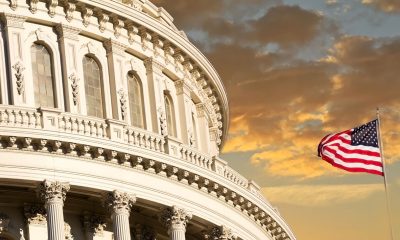Activism
California Senate Gets Second Chance to Pass Prison Slavery Bill This Week
“One of the preliminary recommendations in our report was to support ACA 3,” said Los Angeles attorney Kamilah V. Moore, chairperson of Task Force. “The Task Force saw how that type of legislation aligns perfectly with the idea of reparations for African Americans.”

By Antonio Ray Harvey, California Black Media
On June 23, the California Senate rejected a constitutional amendment to remove language in the state Constitution that allows involuntary servitude as punishment to a crime with a 21-6 vote.
The 13th Amendment of the United States Constitution, ratified in 1865, prohibits slavery and involuntary servitude with one exception: if involuntary servitude was imposed as punishment for a crime.
The state of California is one of nine states in the country that permits involuntary servitude as a criminal punishment.
Article I, section 6, of the California Constitution, describes the same prohibitions on slavery and involuntary servitude and the same exception for involuntary servitude as punishment for crime.
The number of votes cast in favor of Assembly Constitutional Amendment (ACA) 3, the California Abolition Act, fell short of the two-thirds vote requirement needed to move the bill to the ballot for Californians to decide its fate in the November General Election.
The Senate is expected to hold another floor vote on the legislation this week.
Sen. Sydney Kamlager (D-Los Angeles), who authored ACA 3 in 2021 while serving in the Assembly, said she focused the language in the bill on the slavery ban and vowed to bring it back for a vote when Sen. Steven Bradford (D-Gardena), chair of the California Legislative Black Caucus, asked her about it June 23.
“The CA State Senate just reaffirmed its commitment to keeping slavery and involuntary servitude in the state’s constitution,” Kamlager tweeted.
Jamilia Land, a member of the Anti-Violence Safety, and Accountability Project (ASAP), an organization that advocates for prisoners’ rights, said she remains committed to making sure slavery is struck out of the California constitution.
“All we needed was 26 votes,” Land said. “But we have made amendments to ACA 3 on (June 24). Now it could either go back to the Senate on (June 27) or Thursday, June 30.”
Five Republicans and one Democrat, Steve Glazer (D-Orinda), voted against the amendment.
He stated that the issue is “certainly a question worthy of debate” and “can be addressed without a constitutional amendment.”
“Slavery was an evil that will forever be a stain on the history of our great country. We eliminated it through the Civil War and the adoption of the 13th Amendment,” Glazer said in a June 23 statement. “Involuntary servitude — though lesser known — also had a shameful past. ACA 3 is not even about involuntary servitude — at least of the kind that was practiced 150 years ago. The question this measure raises is whether or not California should require felons in state or local jails prisons to work.”
Glazer said that the Legislative Counsel’s office gave him a “simple amendment” that involuntary servitude would “not include any rehabilitative activity required of an incarcerated person,” including education, vocational training, or behavioral or substance abuse counseling.
The Counsel also suggested that the amendment does not include any work tasks required of an incarcerated person that “generally benefit the residents of the facility in which the person is incarcerated, such as cooking, cleaning, grounds keeping, and laundry.”
“Let’s adopt that amendment and then get back to work on the difficult challenge of making sure our prisons are run humanely, efficiently and in a way that leads to the rehabilitation of as many felons as possible,” Glazer added.
Kamlager says “involuntary servitude is a euphemism for forced labor” and the language should be stricken from the constitution.
The state’s Department of Finance (DOF) estimated that the amendment would burden California taxpayers with $1.5 billion annually in wages to prisoners, DOF analyst Aaron Edwards told Senate the Appropriations Committee on June 16.
“These are facts that we think would ultimately determine the outcome of future litigation and court decisions,” Edwards said. “The largest potential impact is to the California Department of Corrections and Rehabilitation, which currently employs around 65,000 incarcerated persons to support central prison operations such as cooking, cleaning, and laundry services.”
Right before the Juneteenth holiday weekend, the appropriations committee sent ACA 3 to the Senate floor with a 5-0 majority vote after Kamlager refuted Edwards’ financial data.
This country has been having “economic discussions for hundreds of years around slavery, involuntary servitude, and indentured servants” and enslavement still exists in the prison system, Kamlager said. She also added that a conflict was fought over the moral issue of slavery.
“This bill does not talk about economics. It’s a constitutional amendment,” Kamlager said. “The (DOF) is not talking about any of this in this grotesque analysis about why it makes more sense for the state of California to advocate for and allow involuntary servitude in prisons. I think (this conversation) is what led to the Civil War.”
Three states have voted to abolish slavery and involuntary servitude — Colorado, Utah, and Nebraska — and in all three cases, the initiative was bipartisan and placed on the ballot by a unanimous vote of legislators, according to Max Parthas, the co-director of the Abolish Slavery National Network (ASNN).
ACA 3 is already attached to a report that addresses the harms of slavery. The Task Force to Study and Develop Reparation Proposals for African Americans issued its interim report to the California Legislature on June 1.
The report included a set of preliminary recommendations for policies that the California Legislature could adopt to remedy those harms, including its support for ACA 3. It examines the ongoing and compounding harms experienced by African Americans as a result of slavery and its lingering effects on American society today.
“One of the preliminary recommendations in our report was to support ACA 3,” said Los Angeles attorney Kamilah V. Moore, chairperson of Task Force. “The Task Force saw how that type of legislation aligns perfectly with the idea of reparations for African Americans.”
Activism
Big God Ministry Gives Away Toys in Marin City
Pastor Hall also gave a message of encouragement to the crowd, thanking Jesus for the “best year of their lives.” He asked each of the children what they wanted to be when they grow up.

By Godfrey Lee
Big God Ministries, pastored by David Hall, gave toys to the children in Marin City on Monday, Dec. 15, on the lawn near the corner of Drake Avenue and Donahue Street.
Pastor Hall also gave a message of encouragement to the crowd, thanking Jesus for the “best year of their lives.” He asked each of the children what they wanted to be when they grew up.
Around 75 parents and children were there to receive the presents, which consisted mainly of Gideon Bibles, Cat in the Hat pillows, Barbie dolls, Tonka trucks, and Lego building sets.
A half dozen volunteers from the Big God Ministry, including Donnie Roary, helped to set up the tables for the toy giveaway. The worship music was sung by Ruby Friedman, Keri Carpenter, and Jake Monaghan, who also played the accordion.
Big God Ministries meets on Sundays at 10 a.m. at the Mill Valley Community Center, 180 Camino Alto, Mill Valley, CA Their phone number is (415) 797-2567.
Activism
First 5 Alameda County Distributes Over $8 Million in First Wave of Critical Relief Funds for Historically Underpaid Caregivers
“Family, Friend, and Neighbor caregivers are lifelines for so many children and families in Alameda County,” said Kristin Spanos, CEO, First 5 Alameda County. “Yet, they often go unrecognized and undercompensated for their labor and ability to give individualized, culturally connected care. At First 5, we support the conditions that allow families to thrive, and getting this money into the hands of these caregivers and families at a time of heightened financial stress for parents is part of that commitment.”

Family, Friend, and Neighbor Caregivers Can Now Opt Into $4,000 Grants to Help Bolster Economic Stability and Strengthen Early Learning Experiences
By Post Staff
Today, First 5 Alameda County announced the distribution of $4,000 relief grants to more than 2,000 Family, Friend, and Neighbor (FFN) caregivers, totaling over $8 million in the first round of funding. Over the full course of the funding initiative, First 5 Alameda County anticipates supporting over 3,000 FFN caregivers, who collectively care for an estimated 5,200 children across Alameda County. These grants are only a portion of the estimated $190 million being invested into expanding our early childcare system through direct caregiver relief to upcoming facilities, shelter, and long-term sustainability investments for providers fromMeasure C in its first year. This investment builds on the early rollout of Measure C and reflects a comprehensive, system-wide strategy to strengthen Alameda County’s early childhood ecosystem so families can rely on sustainable, accessible care,
These important caregivers provide child care in Alameda County to their relatives, friends, and neighbors. While public benefits continue to decrease for families, and inflation and the cost of living continue to rise, these grants provide direct economic support for FFN caregivers, whose wages have historically been very low or nonexistent, and very few of whom receive benefits. As families continue to face growing financial pressures, especially during the winter and holiday season, these grants will help these caregivers with living expenses such as rent, utilities, supplies, and food.
“Family, Friend, and Neighbor caregivers are lifelines for so many children and families in Alameda County,” said Kristin Spanos, CEO, First 5 Alameda County. “Yet, they often go unrecognized and undercompensated for their labor and ability to give individualized, culturally connected care. At First 5, we support the conditions that allow families to thrive, and getting this money into the hands of these caregivers and families at a time of heightened financial stress for parents is part of that commitment.”
The funding for these relief grants comes from Measure C, a local voter-approved sales tax in Alameda County that invests in young children, their families, communities, providers, and caregivers. Within the first year of First 5’s 5-Year Plan for Measure C, in addition to the relief grants to informal FFN caregivers, other significant investments will benefit licensed child care providers. These investments include over $40 million in Early Care and Education (ECE) Emergency Grants, which have already flowed to nearly 800 center-based and family child care providers. As part of First 5’s 5-Year Plan, preparations are also underway to distribute facilities grants early next year for child care providers who need to make urgent repairs or improvements, and to launch the Emergency Revolving Fund in Spring 2026 to support licensed child care providers in Alameda County who are at risk of closure.
The FFN Relief Grants recognize and support the essential work that an estimated 3,000 FFN caregivers provide to 5,200 children in Alameda County. There is still an opportunity to receive funds for FFN caregivers who have not yet received them.
In partnership with First 5 Alameda County, Child Care Payment Agencies play a critical role in identifying eligible caregivers and leading coordinated outreach efforts to ensure FFN caregivers are informed of and able to access these relief funds.FFN caregivers are eligible for the grant if they receive a child care payment from an Alameda County Child Care Payment Agency, 4Cs of Alameda County, BANANAS, Hively, and Davis Street, and are currently caring for a child 12 years old or younger in Alameda County. Additionally, FFN caregivers who provided care for a child 12 years or younger at any time since April 1, 2025, but are no longer doing so, are also eligible for the funds. Eligible caregivers are being contacted by their Child Care Payment Agency on a rolling basis, beginning with those who provided care between April and July 2025.
“This money is coming to me at a critical time of heightened economic strain,” said Jill Morton, a caregiver in Oakland, California. “Since I am a non-licensed childcare provider, I didn’t think I was eligible for this financial support. I was relieved that this money can help pay my rent, purchase learning materials for the children as well as enhance childcare, buy groceries and take care of grandchildren.”
Eligible FFN caregivers who provided care at any time between April 1, 2025 and July 31, 2025, who haven’t yet opted into the process, are encouraged to check their mail and email for an eligibility letter. Those who have cared for a child after this period should expect to receive communications from their child care payment agency in the coming months. FFN caregivers with questions may also contact the agency they work with to receive child care payments, or the First 5 Alameda help desk, Monday through Friday, from 9 a.m. to 5:00 p.m. PST, at 510-227-6964. The help desk will be closed 12/25/25 – 1/1/26. Additional grant payments will be made on a rolling basis as opt-ins are received by the four child care payment agencies in Alameda County.
Beginning in the second year of Measure C implementation, FFN caregivers who care for a child from birth to age five and receive an Alameda County subsidized voucher will get an additional $500 per month. This amounts to an annual increase of about $6,000 per child receiving a subsidy. Together with more Measure C funding expected to flow back into the community as part of First 5’s 5-Year Plan, investments will continue to become available in the coming year for addressing the needs of childcare providers in Alameda County.
About First 5 Alameda County
First 5 Alameda County builds the local childhood systems and supports needed to ensure our county’s youngest children are safe, healthy, and ready to succeed in school and life.
Our Mission
In partnership with the community, we support a county-wide continuous prevention and early intervention system that promotes optimal health and development, narrows disparities, and improves the lives of children from birth to age five and their families.
Our Vision
Every child in Alameda County will have optimal health, development, and well-being to reach their greatest potential.
Learn more at www.first5alameda.org.
Activism
2025 in Review: Seven Questions for Assemblymember Lori Wilson — Advocate for Equity, the Environment, and More
Her rise has also included several historic firsts: she is the only Black woman ever appointed to lead the influential Assembly Transportation Committee, and the first freshman legislator elected Chair of the California Legislative Black Caucus. She has also been a vocal advocate for vulnerable communities, becoming the first California legislator to publicly discuss being the parent of a transgender child — an act of visibility that has helped advanced representation at a time when political tensions related to social issues and culture have intensified.

By Edward Henderson, California Black Media
Assemblymember Lori D. Wilson (D-Suisun City) joined the California Legislature in 2022 after making history as Solano County’s first Black female mayor, bringing with her a track record of fiscal discipline, community investment, and inclusive leadership.
She represents the state’s 11th Assembly District, which spans Solano County and portions of Contra Costa and Sacramento Counties.
Her rise has also included several historic firsts: she is the only Black woman ever appointed to lead the influential Assembly Transportation Committee, and the first freshman legislator elected Chair of the California Legislative Black Caucus. She has also been a vocal advocate for vulnerable communities, becoming the first California legislator to publicly discuss being the parent of a transgender child — an act of visibility that has helped advanced representation at a time when political tensions related to social issues and culture have intensified.
California Black Media spoke with Wilson about her successes and disappointments this year and her outlook for 2026.
What stands out as your most important achievement this year?
Getting SB 237 passed in the Assembly. I had the opportunity to co-lead a diverse workgroup of colleagues, spanning a wide range of ideological perspectives on environmental issues.
How did your leadership contribute to improving the lives of Black Californians this year?
The Black Caucus concentrated on the Road to Repair package and prioritized passing a crucial bill that remained incomplete during my time as chair, which establishes a process for identifying descendants of enslaved people for benefit eligibility.
What frustrated you the most this year?
The lack of progress made on getting Prop 4 funds allocated to socially disadvantaged farmers. This delay has real consequences. These farmers have been waiting for essential support that was promised. Watching the process stall, despite the clear need and clear intent of the voters, has been deeply frustrating and reinforces how much work remains to make our systems more responsive and equitable.
What inspired you the most this year?
The resilience of Californians persists despite the unprecedented attacks from the federal government. Watching people stay engaged, hopeful, and determined reminded me why this work matters and why we must continue to protect the rights of every community in our state.
What is one lesson you learned this year that will inform your decision-making next year?
As a legislator, I have the authority to demand answers to my questions — and accept nothing less. That clarity has strengthened my approach to oversight and accountability.
In one word, what is the biggest challenge Black Californians are facing currently?
Affordability and access to quality educational opportunities.
What is the goal you want to achieve most in 2026?
Advance my legislative agenda despite a complex budget environment. The needs across our communities are real, and even in a tight fiscal year, I’m committed to moving forward policies that strengthen safety, expand opportunity, and improve quality of life for the people I represent.
-

 Alameda County4 weeks ago
Alameda County4 weeks agoSeth Curry Makes Impressive Debut with the Golden State Warriors
-

 Bay Area2 weeks ago
Bay Area2 weeks agoPost Salon to Discuss Proposal to Bring Costco to Oakland Community meeting to be held at City Hall, Thursday, Dec. 18
-

 #NNPA BlackPress4 weeks ago
#NNPA BlackPress4 weeks agoFBI Report Warns of Fear, Paralysis, And Political Turmoil Under Director Kash Patel
-

 Activism2 weeks ago
Activism2 weeks agoMayor Lee, City Leaders Announce $334 Million Bond Sale for Affordable Housing, Roads, Park Renovations, Libraries and Senior Centers
-

 Activism3 weeks ago
Activism3 weeks agoOakland Post: Week of December 10 – 16, 2025
-

 Arts and Culture2 weeks ago
Arts and Culture2 weeks agoFayeth Gardens Holds 3rd Annual Kwanzaa Celebration at Hayward City Hall on Dec. 28
-

 Activism2 weeks ago
Activism2 weeks agoOakland School Board Grapples with Potential $100 Million Shortfall Next Year
-

 #NNPA BlackPress4 weeks ago
#NNPA BlackPress4 weeks agoMoney, the NCAA and College Athletics: Congress Considers Changes to Name, Image and Likeness Rules

























































